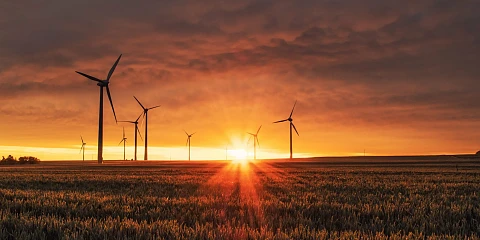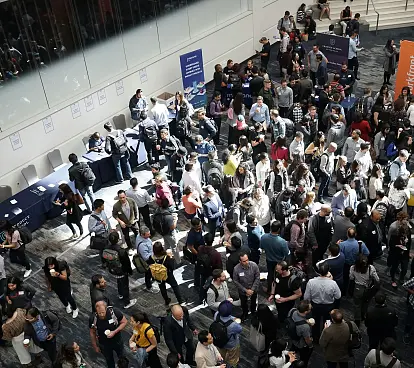
The shift toward a sustainable energy system
January 2, 2023
The rapid development of the Covid-19 vaccines has shown that when the scientific community works hand-in-hand with the private sector and is supported by governments, spectacular feats can be achieved. We’ve been able to find a solution to one of the worst crises faced by the modern world faster than anyone had imagined. Shouldn’t we able to do the same with climate change?
The first step to addressing climate change with the same urgency as Covid-19 is creating awareness. Society as a whole should be able to agree on the problem and possible solutions. The trouble here is that climate change isn’t as simple as a virus and vaccines won’t be able to cure it. There is a complex network of factors fueling climate change, and the solutions will likely be equally diverse.
In any case, we already understand the problem of climate change well enough to be able to draw up a plan. One of the most obvious areas where we need to work is our energy system. Fossil fuels have made it possible for our societies to develop unprecedented comforts, prosperity and welfare states. But they’re not sustainable. We must change the energy system as soon as possible to reduce pollution and greenhouse gas emissions.
The good thing about looking to change the energy system is that we already have the solutions. But resistance to some of these changes, especially because they may involve making certain sacrifices in the short term, is holding the change back. But what we need is long-term thinking. Most people understand that even if there are some side effects from a Covid-19 vaccine, it will be worth it in the end. Prevention is better than cure. We should think in the same way about climate change.
Once societies decide to address this challenge, at the individual, private and public levels, we’ll be able to spring into action. There’s no doubt that collective human ingenuity, backed by technology like AI, will help get us out of this massive problem.
The role of energy in the Sustainable Development Goals
Energy and utilities are mentioned in the UN’s Sustainable Development Goals. All of the UN states have committed to reaching these goals by 2030 to create a future that is more sustainable for humanity and the planet that gives us life. Specifically, SDG 6 aims to “ensure availability and sustainable management of water and sanitation for all.” SDG 7 is to "ensure access to affordable, reliable, sustainable and modern energy for all". SDG 9 is to "build resilient infrastructure, promote inclusive and sustainable industrialization, and foster innovation" and SDG 12 is to “ensure sustainable consumption and production patterns".
Everything we can do to make our energy system more sustainable will help us achieve these goals, which aim to improve not only the environmental crisis but empower people’s lives around the world.
The green energy solutions that will help us overcome climate change
Now that we know the importance of technological innovation in the energy sector, we’ll look at some of the most exciting fields at the moment. We’ll pay particular attention to the ones that are already being applied in the real world.
The unstoppable power of renewable energy
Just like how digital technology has advanced at mind-boggling speeds over the last decades, renewable energy technology has too. Already, we can see solar panels are dotting more and more rooftops. Solar farms are replacing old smokestacks. Wind turbines are no longer a rare sight on land or in the sea. We hope that electric vehicles will soon become the norm worldwide. Although there is a lot to do, we are on the right path to a better energy system. We just have to step on the accelerator so that it will help us prevent more problems in the future.
Energy production systems
This is the most visible part of the new model of green energy generation. This sector has seen major innovations in recent years, especially around energy efficiency, energy generation and production capacity. All the innovations have helped green energy become a real alternative to contaminating energy sources.
IoT Hardware
These devices have been enormously useful for improving the management of energy generation infrastructures. These connected sensors are increasingly relevant when it comes to boosting efficiency and usefulness. These devices will only become more central when Edge Computing and 5G take effect more broadly.
Software, Big Data and AI
together, these three technologies improve decision-making, energy efficiency and production management. Besides IoT hardware, we have software and databases that feed into the connected sensors and allow us to better manage and optimize energy generation and flow. One example is software designed for solar farms by the Spanish startup RatedPower.
VR and AR technology
we can use virtual reality, augmented reality and extended reality to improve the management of energy infrastructure. They offer new ways of visualizing information, which can help us maintain the energy generation hardware more efficiently and remotely.
Energy communities
Energy communities that organize collective and citizen-driven energy actions through generating, consuming, sharing or selling electricity, or by providing flexible services through demand-response and storage are becoming increasingly important. This development has been facilitated by the Internet’s ability to connect people and boost collaboration. This phenomenon has drawn heavily from social networks and the collaborative economy, just like platforms for collaborative transport or housing. One example is Sngular’s Smart Grid project that was created for an international client who wanted to develop a P2P energy trading system managed by a blockchain-based smart agent system. Its added value lies in its contribution to the efficient management of household connected devices and in maximizing the benefits of the prosumers as they buy and sell their excess renewable energy. Thanks to blockchain technology, it offers a new layer of trust and stability for all the agents who make up the system.
Electric mobility
Electric mobility is becoming a huge catalyst for the adoption of renewable energy. It wouldn’t make much sense to invest in electric vehicles that are getting their electricity from polluting energy sources like coal. Here, we can see that there has been a sea change in consumers’ mentalities, which has been influenced by both environmental awareness and the private sector. Tesla, for example, has been dedicated to creating an attractive image of EVs. Although the shift to electric vehicles has taken longer than many would have liked, we are currently witnessing a major transformation of the automobile sector in terms of personal vehicles, collective transport vehicles like buses and even semis. Several technological factors have had to come together to make this possible:
- Battery storage technology has advanced dramatically in recent years and helped give rise to electric motors. This has been key to helping vehicles appeal to users who are used to being able to drive long distances.
- Charging stations are another fundamental piece of the pie, allowing EV owners to charge their cars in the cities or on the highways, just like stopping to fill their cars with gasoline. One of the advantages of charging systems is that they don’t require the infrastructure of entire gas stations and therefore can be spread out more widely. However, EVs still take longer to charge than it would take to fill up the tank of an internal combustion vehicle.
Smart Networks
Where, for example, drones, AI imagine networks and Edge Computing can be used to check on the state of infrastructures. In most cases, problems need more than one technology to solve them – hardware needs software and software needs the internet. In this case, we are talking about cutting-edge hardware like drones combined with the image recognition capacities of AI and the processing power of Edge Computing. The combination is exponentially better than the sum of the parts. That’s why we’re talking about smart networks, as the entire package can drastically improve the management of our energy networks.
The circular economy
Is another important pillar of the changing energy system. It’s not only a technical issue, but also about changing mindsets to accelerate change. Even though individuals can follow some of the recommendations, it’s a practice that various industries should consider deeply. This includes energy, waste and water management, all of which are fundamental to a sustainable model of development.
Energy storage technologies
This is a major challenge for energy produced by renewable sources. Since the sun and wind are changing, energy generation does not always match up with consumption. That means large and efficient storage systems are needed. It requires improvements in battery technology, and not just conventional batteries, but also innovative ideas that use compressed air or even gravity energy storage.
Looking to the future
We should also consider other complementary forms of energy. Nuclear energy is especially interesting, with the development of generation IV reactors, as promoted by companies like TerraPower. There is also geothermal energy or the use of hydrogen to replace conventional fuels.
The benefits of shifting our energy system
The big challenge for any initiative that wants to bring change to our energy system is convincing the different agents in the market that the changes will benefit them.
Although these initiatives may require hard work and short-term sacrifice, we are increasingly certain that in the mid to long term, this is the best possible approach.
Spain’s Foro para la Electrificación (Forum for Electrification) highlights that one of the major benefits of shifting to greener energy is job creation. This is particularly important as we emerge from the Covid-19 pandemic.
According to a recent study by the International Renewable Energy Agency, renewable energy can generate three times more employment than fossil fuels. Specifically, the agency estimates that it will create 6 million jobs around the world in the coming years if green energy becomes a priority in the Covid-19 recovery packages. In 2018, around 11 million people were already working in the industry.
The Spanish government estimates that investment in renewable energy will create between 107,000 and 135,000 net jobs. At the same time, investments in energy efficiency could create another 50,000 to 100,000 posts. Indirectly, the government calculates that the transition to renewable energy could create a further 120,000 indirect jobs and that investments in improving the electricity grid could lead to another 50,000.
As time carries on, we’ll become increasingly aware of the benefits of this new energy system. It is estimated that air pollution from burning fossil fuels resulted in 8.7 million deaths globally in 2018. Once traditional vehicles give way to electric ones in cities, we’ll likely look back in disbelief about how we accepted such dangerous levels of pollution in our air.
Our latest news
Interested in learning more about how we are constantly adapting to the new digital frontier?

Event
October 20, 2025
Sngular is heading to the Global Health Exhibition 2025 in Riyadh, Saudi Arabia

Corporate news
April 22, 2025
Sngular and Fakeeh Care Group join forces to create an AI Center of Excellence in KSA

Insight
April 7, 2025
World Health Day in the AI revolution era

Tech Insight
March 5, 2025
AI Governance: Challenges and Perspectives